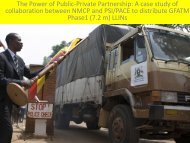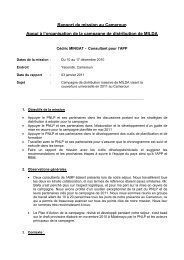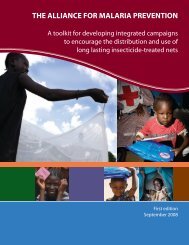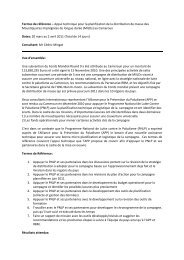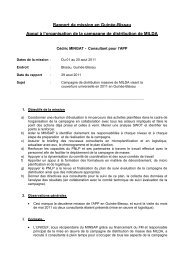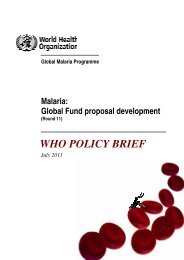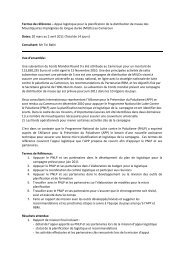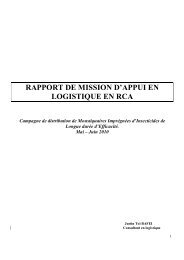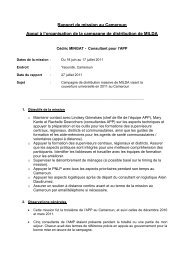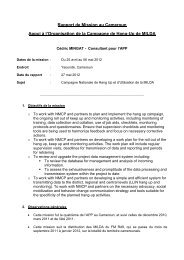Checklist for Program Managers and Independent Observers
Checklist for Program Managers and Independent Observers
Checklist for Program Managers and Independent Observers
- No tags were found...
Create successful ePaper yourself
Turn your PDF publications into a flip-book with our unique Google optimized e-Paper software.
<strong>Checklist</strong> on LLIN Mass DistributionFOREWORD:Many African countries are in the process of rapidly scaling up ownership <strong>and</strong> use of LLINs through the process ofmass distribution. LLIN campaigns aim to achieve high coverage <strong>for</strong> effective malaria prevention, typically settingthe objective of ensuring that100% of the population at risk of malaria has access <strong>and</strong> 80% of people use LLINs.Recent experience in several countries has identified some key planning <strong>and</strong> operational issues such as insufficientquantification of net need, delayed procurement of LLINs <strong>and</strong> necessary materials, <strong>and</strong> incomplete householdregistration that prevent the achievement of full coverage <strong>and</strong> thus reduce effectiveness. Most of these problemsare identified either during implementation or in post campaign surveys, when it is too late to correct issues <strong>and</strong>usually very expensive.NetWorks has looked at how these problems could be identified at the early stages of planning <strong>for</strong> mass LLINdistribution <strong>and</strong> resolved in real-time to assure the campaign’s success. This guideline has been developed asa companion to the Alliance <strong>for</strong> Malaria Prevention’s “Toolkit <strong>for</strong> mass distribution campaigns to increasecoverage <strong>and</strong> use of long-lasting insecticide-treated nets” to provide an overview checklist of key quality assuranceprocedures <strong>and</strong> supervisory tools. It is cross-referenced throughout this checklist in parentheses signifying thesection or the page number in the AMP Toolkit where further explanation can be found. Each task is precededby an abbreviation (see below) to signal the person or committee responsible <strong>for</strong> each step in the process. Thechecklist is in chronological order, organized by tasks, counting down to the registration <strong>and</strong> net distribution.<strong>Program</strong> <strong>Managers</strong>, independent observers, <strong>and</strong> partner organizations can also use this checklist to assess if thecampaign planning is on track.This checklist is aimed to be practical <strong>and</strong> offers a wide range of advice <strong>and</strong> tools. All advice <strong>and</strong> tools must beadapted to each country’s context, as strategies <strong>for</strong> malaria control (particularly LLIN strategy), the culturalcontext, <strong>and</strong> the organization of the health system have a significant impact on the way a campaign should beplanned <strong>and</strong> implemented.The following abbreviations are used to denote the particular subcommittee or group responsible <strong>for</strong> carrying outeach task. In some instances, depending on partnerships <strong>and</strong> NMCP staff availability, it is not always possible tohave all of the separate subcommittees listed below. For example, if there is not enough staff to make a full M&Esubcommittee, tasks labeled “M&E” may fall under TECH responsibility. These abbreviations are meant to beguidelines to assist with delegating tasks.COMM: Communications subcommitteeCOORD: National Coordinating CommitteeLOG: Logistics subcommitteeM&E: Monitoring <strong>and</strong> Evaluation subcommitteeMOH: Ministry of HealthTECH: Technical or Planning subcommittee3
12-18 MONTHS PRIORPROCUREMENT£ MOH/COORD: Clearly define target population, using multiple sources of data <strong>for</strong> accuratequantification, <strong>and</strong> agree on the definition of a household (section 4.1, pp 4-2).£ MOH/COORD: Calculate LLIN needs <strong>for</strong> universal coverage (population divided by 1.8) prior toprocurement (section 3.3, pp 3-10).£ MOH/Procurement Agent: Release transparent tender <strong>for</strong> LLINs following the procurement guidelinesof the relevant donor(s) with clear specifications of requirements, deadline <strong>for</strong> submission of bids, <strong>and</strong>award criteria (section 4-6, pp 4-5 <strong>and</strong> 8-13). Identify procurement process <strong>for</strong> goods that can be sourcedlocally.9-12 MONTHS PRIORPLANNING/COORDINATION£ COORD: Establish a National Coordinating Committee [NCC] (section 2.2, pp 2-2).£ COORD: Establish <strong>and</strong> follow a schedule of regular planning meetings, at the same time, day of theweek, <strong>and</strong> location to maintain consistency.£ COORD: Provide regular updates to partners via email on meeting outcomes, action points <strong>and</strong>timelines <strong>for</strong> follow up. Updates should be daily or every-other-day while key campaign activities arein progress (household registration, LLIN distribution).£ COORD: Define a feasible <strong>and</strong> appropriate implementation strategy <strong>and</strong> share with involved partners(section 3.2, pp 3-2).9 MONTHS PRIORCOORDINATION£ COORD: Communicate frequently (monthly, then biweekly <strong>and</strong> weekly in the months just be<strong>for</strong>e thecampaign) with regional <strong>and</strong> district level committees <strong>and</strong> officials (section 2.4, pp 2-5).£ COORD: Establish regional coordinating committees <strong>and</strong> initially meet monthly, then more frequentlyas the campaign approaches (section 2.3, pp 2-4).4
<strong>Checklist</strong> on LLIN Mass Distribution8 MONTHS PRIORPLANNING/COORDINATION£ COORD: Establish subcommittees <strong>for</strong> technical/planning, logistics, communications, finance, <strong>and</strong>M&E, <strong>and</strong> agree on a regular (weekly or biweekly) meeting day <strong>and</strong> time, (section 2.3, pp 2-4).£ COORD: Develop a clear <strong>and</strong> concise terms of reference <strong>for</strong> each subcommittee (Appendices 2A-2C, pp 2-9, 2-10, 2-11).£ LOG: Identify members of central logistics team (CLT).7 MONTHS PRIORPLANNING£ COORD, TECH/LOG/COMM: Develop <strong>and</strong> share a plan of action (or implementation guideline),linked to macroquantification <strong>for</strong> LLINs <strong>and</strong> all other materials (section 3.4, pp 3-13), as well as neededpersonnel (section 3.5, pp 3-20).£ Develop supporting plans <strong>for</strong> specific sub-committees (M&E, Logistics, Communication, Finance,etc.), including timelines <strong>and</strong> budgets <strong>for</strong> activities.£ COORD/FINANCE: Develop an estimated macro budget <strong>for</strong> all activities, showing funds available<strong>and</strong> gaps, <strong>and</strong> share it with partners (Appendix 3A, pp 3-33).£ COORD/TECH/LOG/COMM/M&E: Consider urban <strong>and</strong> rural zones <strong>and</strong> make sure differences indistribution needs are reflected in the plan of action <strong>and</strong> supporting sub-committee plans(section 3.5, pp3-23).£ COORD/TECH/LOG/COMM: Develop terms of reference <strong>for</strong> household registration <strong>and</strong>distribution team personnel (section 3.5, pp 3-22).£ COORD/M&E: Begin planning <strong>and</strong> development of a monitoring <strong>and</strong> evaluation system <strong>and</strong> tools <strong>for</strong>during <strong>and</strong> after the distribution. Include a detailed supervision plan <strong>and</strong> full budget (section 8.1, pp 8-2).£ COORD/MOH: Validate the plan of action (section 3.7, pp 3-27), <strong>and</strong> establish an appropriate timeline(Appendix 3B).£ TECH/LOG/COMM/COORD: Develop <strong>and</strong> finalize microplanning templates that includequantification <strong>and</strong> activities <strong>for</strong> all subcommittees.£ TECH/LOG/COMM/COORD: Complete microplanning (section 7.2, pp 7-2) <strong>and</strong> budgeting at thedistrict <strong>and</strong> regional levels <strong>and</strong> share it with all partners—4-7 months.5
£ COORD/FINANCE: Validate district microplans <strong>and</strong> budgets at the central level <strong>and</strong> share withdistricts prior to distribution, <strong>and</strong> ensure finals versions are sent back down to districts <strong>and</strong> regions(section 7.2, pp 7-3).£ TECH: Create a waste management plan (<strong>for</strong> packaging <strong>and</strong> other detritus) in advance <strong>and</strong> communicateit to all sites (section 3.4, pp 3-19).LOGISTICS£ TECH/LOG/COMM/COORD: Develop, validate, <strong>and</strong> share the logistics plan of action (section 5.2,pp 5-9).£ COORD/LOG: Identify dedicated logistics focal points at all levels (e.g. central, regional <strong>and</strong> district)where nets will be received <strong>and</strong> stored.£ Plan <strong>for</strong> training of all personnel who will be involved in the LLIN logistics <strong>and</strong> <strong>for</strong> provision ofresources to manage the supply chain.£ Identify all items requiring national (in country) procurement <strong>and</strong> ensure planning timelinesaccount <strong>for</strong> the procurement process.£ LOG: Assess warehousing <strong>and</strong> storage well in advance of campaign(section 5.1, pp 5-5).£ Make sure there is sufficient capacity; good accessibility; dry <strong>and</strong> secure with locks, lighting, guards<strong>and</strong> access control (section 5.1, pp 5-5).£ LOG: Develop the logistics micro-plan at the district level <strong>and</strong> share it with the regional level (appendix5B).£ LOG: Develop a transport plan directly from the logistics microplan, <strong>and</strong> tender it <strong>for</strong> bids (section 5.1,pp 5-7).£ TECH/LOG: Identify distribution sites as part of the microplanning process (section 7.2, pp 7-7).£ LOG: Develop <strong>and</strong> validate a net pre-positioning plan from district to distribution points as part of themicroplanning process (Resources R5-4 <strong>and</strong> R5-5).£ TECH/LOG: Plan <strong>and</strong> budget <strong>for</strong> a re-positioning of nets in advance, should it be necessary (section 7.6,pp 7-25).MONITORING AND EVALUATION£ TECH/M&E: Make sure to budget sufficient time, fuel <strong>and</strong> other costs into the supervision section ofthe M&E plan so that supervision teams can assess activities in remote or hard to reach areas, not just‘main road’ communities.6
LOGISTICS£ LOG/TECH/COORD: Develop stock sheets, waybills, tally sheets, <strong>and</strong> goods-received notes (Appendix5A, pp 5-20).COMMUNICATION£ COMM: Have communication plans approved at district level as part of the microplanning meetings.£ COMM: Pre-test all materials with members of the target audience in advance of final printing <strong>and</strong>dissemination, to avoid wasting resources on poor or confusing messages (section 6.4, pp 6-11; section 6.7,pp 6-18; Appendix 6C). Modify the communication plan as needed to account <strong>for</strong> the local context.5 MONTHS PRIORLOGISTICS£ LOG: Hold the logistics trainings. Make sure that each level of training goes into sufficient depth so thatall actors involved are familiar with procedures <strong>for</strong> transport, storage <strong>and</strong> reporting, <strong>and</strong> other supplychain management tools to ensure accountability (Section 5.8, pp 5-18; Resources 5-6 through 5-15).TRAINING£ COORD: Plan registration, distribution <strong>and</strong> hang up (if planned) training courses at national, district<strong>and</strong> health facility level.£ Cascade trainings of no more than 3 levels are recommended (national trains regional <strong>and</strong> districtsupervisors/medical officers; district trains head nurses/heads of post; heads of post train volunteers)(Appendix 5D, pp 5-33).£ COORD: Develop training budgets <strong>and</strong> ensure that they are fully funded. Fund supervisors to overseeeach training level to ensure quality. Trainings should be a minimum of 2 days each <strong>for</strong> registration <strong>and</strong>distribution (section 3.8, pp 3-32).4 MONTHS PRIORPLANNING£ COORD: Develop, validate, <strong>and</strong> share a supervision plan <strong>for</strong> all levels with partners <strong>and</strong> districts prior tohousehold registration <strong>and</strong> LLIN distribution (section 3.5, pp 3-25).8
<strong>Checklist</strong> on LLIN Mass DistributionLOGISTICS£ LOG: During positioning of nets, conveyers should travel with trucks to drop-off points (section 5.8, pp5-19).£ Nets are dropped off at regional holding location—1-4 months prior£ LOG: Use sufficient security <strong>and</strong> appropriate tracking documents at each storage facility to ensure no lossof LLINs (section 5.1, pp 5-7).£ SUPERVISORS/LOG: During all transport, verify stock sheets, waybills, tally sheets, <strong>and</strong> goods-receivednotes (Appendix 5A, pp 5-20).£ LOG/Region-District Team: Immediately report any discrepancy in stock numbers (by warehousemanagers) <strong>and</strong> share this in<strong>for</strong>mation up the chain to the Central Logistics Team (CLT) <strong>and</strong> NCC.MONITORING AND EVALUATION£ COORD/TECH/LOG/COMM: Assign a dedicated supervision team to conduct in <strong>and</strong> end processevaluations <strong>and</strong> provide a clear terms of reference (section 8.1, pp 8-2).£ M&E/TECH: Develop a data management plan <strong>for</strong> timely collection <strong>and</strong> collation of in<strong>for</strong>mationcollected during the household registration <strong>and</strong> LLIN distribution.COMMUNICATION£ COMM: Following pre-testing, review revised materials, <strong>and</strong> have them approved by the communicationssub-committee.REPORTING£ TECH: Clearly share reporting deadlines <strong>and</strong> <strong>for</strong>mats <strong>and</strong> include the deadlines in trainings at theregional <strong>and</strong> district levels (section 7.7, pp 7.26).3 MONTHS PRIORTRAINING£ COORD: Ensure all training materials are available in time <strong>for</strong> each training level. Training manualsshould include instructions <strong>for</strong> trainers, <strong>and</strong> not simply contain lists of in<strong>for</strong>mation to pass on. Plan tomake practice <strong>for</strong>ms available <strong>for</strong> trainees (section 3.8, pp 3-32).9
£ COORD: Conduct central level training. During the training, use role plays <strong>and</strong> exercises to traincampaign personnel in household allocation of nets <strong>and</strong> in communicating key messages (section 3.4, pp3-16; Appendix 3A, pp 3-37; section 7.4, pp 7-13).£ TECH/LOG: Deliver all necessary <strong>for</strong>ms required <strong>for</strong> registration <strong>and</strong> distribution on time <strong>and</strong> insufficient quantity (Resource 7-33).£ TECH: Make sure that household registration <strong>for</strong>ms are simple <strong>and</strong> provide enough space <strong>for</strong>writing all key in<strong>for</strong>mation.£ TECH: Print vouchers/coupons well in advance <strong>and</strong> a large enough supply <strong>for</strong> each distributionpoint.MONITORING AND EVALUATION£ TECH/SUPERVISORS: Ensure that supervision teams have clear checklists <strong>for</strong> use during householdregistration <strong>and</strong> LLIN distribution appropriate to their supervisory level (national, regional, district,sub-district). Provide these in advance <strong>and</strong> in sufficient quantity, <strong>and</strong> ensure they are included as part oftraining (Resources R7-58 to R7-64 <strong>and</strong> R7-34).COMMUNICATION£ COMM: Produce materials with enough lead-time to allow <strong>for</strong> final revisions <strong>and</strong> transport out to healthfacilities <strong>and</strong> distribution sites. Create a distribution plan <strong>for</strong> materials.2 MONTHS PRIOR (DURING HOUSEHOLD REGISTRATION)TRAINING£ Conduct regional <strong>and</strong> local level trainings on household registration.£ COMM/CENTRAL/REGIONAL/DISTRICT HEALTH OFFICIALS: Train social mobilizationagents <strong>for</strong> household registration <strong>and</strong> provide them with a brief job aid to help keep messages consistent(section 6.3, pp 6-7, <strong>and</strong> section 6.4, pp 6-11)—1-7 days prior to household registration.£ DISTRICT SUPERVISORS: Carry out trainings <strong>for</strong> household registration at the lowest level, with nomore than 30-35 people, immediately be<strong>for</strong>e (1-2 days) beginning registration activities (section 7.4, pp7-13).10
<strong>Checklist</strong> on LLIN Mass DistributionCOMMUNICATION£ COMM: Include DJs from popular local radios in communication trainings or campaign briefingsabout household registration, <strong>and</strong> give them a set of talking points to support campaign communicationactivities (section 6.4, pp 6-11)—1-7 days prior to household registration.£ Make sure radio <strong>and</strong> television stations broadcast the appropriate registration spots or messages as planned(section 6.8, pp 6-19 <strong>and</strong> 6-20; Appendix 8A, pp 8-17 indicator 6).£ CENTRAL/REGIONAL/DISTRICT HEALTH OFFICIALS: Have household registration teamsproperly identified through hats, t-shirts, or aprons (section 6.7, pp 6-19).IMPLEMENTATION£ TECH: Have registration teams visit all households in their catchment area during registration. If there isno one at home, visit the household a second time (section 3.2, pp 3-8; section 7.5, pp 7-14).MONITORING AND EVALUATION£ SUPERVISORS/ALL: Per<strong>for</strong>m rapid assessments (spot-checks) during registration in order to determineareas where registration teams have missed households. This assessment is to determine if geographic areashave been missed during registration (section 7.9, pp 7-30).£ TECH: Send email updates to the national coordinating committee every day or two with the latestupdated figures <strong>and</strong> issues (section 7.7, pp 7.27). This will eventually assist with the prepositioning of nets<strong>for</strong> distribution.£ SUPERVISORS: Supervision teams debrief daily with district, regional <strong>and</strong> national levels by phone oremail (section 7.7, pp 7.27).1 MONTH PRIORIMPLEMENTATION£ TECH: After registration, schedule <strong>and</strong> hold a household registration validation meeting at the districtlevel; have the district coordinating committee validate all data, <strong>and</strong> activate the contingency plan ifstockouts are likely (section 7.6, pp 7-25).LOGISTICS£ LOG: Based on registration activities <strong>and</strong> validations, collate <strong>and</strong> finalize numbers <strong>for</strong> prepositioning ofnets prior to LLIN distribution. Make any last minute changes as needed.11
£ COORD/LOG: Ensure that district level storage facilities receive LLINs as close to distribution datesas possible so that LLINs spend as little time as possible (1-2 weeks maximum) in district-level storagefacilities (section 5.1, pp 5-8).£ LOG: Ensure that LLINs are moved to distribution sites with appropriate storage 1-2 days prior to thebeginning of the LLIN distribution. If there are distribution sites without appropriate storage, ensure thata plan is in place to transport LLINs early on each distribution day <strong>and</strong> to pick them up <strong>for</strong> safe storage atthe end of each day.COMMUNICATION£ COMM: Designate a group of 3-4 communication sub-committee members to coordinate responsesin case crisis communication is needed (section 6.5, pp 6-13). Identify a trusted spokesperson whocan be briefed <strong>and</strong> interviewed if necessary to combat rumors about the campaign – 1 month prior todistribution.£ COMM: Brief journalists on the campaign ahead of time <strong>and</strong> provide them with a press release (appendix6B)—2-4 weeks prior to distribution.£ COMM/COORD/LOG: Verify that communication materials arrive on time at each destination <strong>and</strong> insufficient quantity (section 6.8, pp 6-20) – 1-2 weeks prior to distribution.TRAINING£ COMM/CENTRAL/REGIONAL/DISTRICT HEALTH OFFICIALS: Train social mobilizationagents <strong>for</strong> LLIN distribution <strong>and</strong> provide them with a brief job aid to help keep messages consistent(section 6.3, pp 6-7, <strong>and</strong> section 6.4, pp 6-11)—1-7 days prior to distribution.£ DISTRICT SUPERVISORS: Carry out trainings <strong>for</strong> LLIN distribution at the lowest level, with no morethan 30-35 people, immediately be<strong>for</strong>e (1-2 days) beginning distribution activities (section 7.4, pp 7-13).DURING DISTRIBUTIONCOMMUNICATION£ Make sure radio <strong>and</strong> television stations broadcast the appropriate distribution spots or messages about theLLIN distribution as planned (section 6.8, pp 6-19 <strong>and</strong> 6-20; Appendix 8A, pp 8-17 indicator 6)£ CENTRAL/REGIONAL/DISTRICT HEALTH OFFICIALS: Have distribution teams properlyidentified through hats, t-shirts, or aprons (section 6.7, pp 6-19).£ DISTRICT: Distribution sites should be well-identified <strong>and</strong> have a net hanging to demonstrate how theyshould be hung (section 6.5, pp 6-12).12
<strong>Checklist</strong> on LLIN Mass DistributionIMPLEMENTATION£ COMM/HEALTH FACILITY STAFF: Distribution sites must have shaded waiting areas, efficientflow-patterns, <strong>and</strong> sufficient personnel <strong>for</strong> crowd control, particularly on the first day of distribution <strong>and</strong>in urban areas (section 7.6, pp 7-22 <strong>and</strong> 7-23).£ HEALTH FACILITY STAFF: Report the daily counts of nets up the chain by cell phone <strong>and</strong> ensure thatreporting deadlines are respected—during distribution.MONITORING AND EVALUATION£ SUPERVISORS/ALL: Per<strong>for</strong>m rapid assessments (spot-checks) during LLIN distribution in order todetermine areas where distribution teams have missed households. This assessment is not to establish ITNcoverage but to determine if geographic areas have been missed (section 7.9, pp 7-30).REPORTING£ TECH: Send email updates to the national coordinating committee every day or two with the latestupdated figures <strong>and</strong> issues (section 7.7, pp 7.27)—during distribution.£ SUPERVISORS: Supervision teams debrief daily with district, regional <strong>and</strong> national levels by phone oremail (section 7.7, pp 7.27).1 WEEK AFTER (AFTER DISTRIBUTION)LOGISTICS£ LOG: Carry out a commodity management assessment post-distribution to assess the level ofaccountability <strong>and</strong> transparency achieved in the management <strong>and</strong> distribution of LLINs (section 5.7, pp5-17).MONITORING AND EVALUATION/REPORTING£ COORD: Provide resources <strong>for</strong> post-campaign review meetings at district, then regional <strong>and</strong> nationallevel (section 8.2, pp 8-4)—1 week following distribution.£ COORD: Have a dedicated staff person at district <strong>and</strong> regional level compile <strong>and</strong> share reports withdistrict, regional, <strong>and</strong> national coordinating committees (section 9, pp 9-1)—1-2 weeks after.£ COORD/TECH/LOG/COMM: Share final report with the national coordinating committee (Section8.2, pp 8-4; Appendix 8A, pp 8-17; Resources R9-1 <strong>and</strong> R9-2)—1-2 months after.13
3 MONTHS AFTERMONITORING AND EVALUATION£ COORD/TECH: Undertake post-campaign surveys only if no other large-scale survey (such as a DHS,MIS, MICS, etc) is planned in an appropriate timeframe to assess LLIN ownership <strong>and</strong> utilization(section 8.3, pp 8-10)—3 months after.SUMMARY OF KEY APPENDICESAppendices 2A-2C: Terms of Reference <strong>for</strong> coordinating committeesAppendix 3A-C: Budget template <strong>and</strong> sample timelines (R3-2a <strong>and</strong> 3-2b)Appendices 4A-D: Procurement timelinesAppendices 5A-D: LLIN tracking tools, logistics timeline, logistics budget, <strong>and</strong> logistics monitoring <strong>for</strong>ms (R5-8-21)Appendix 8A: Examples of process <strong>and</strong> output indicators <strong>for</strong> use or adaptation in ITN universal coveragecampaignsResource 7AB – Microplanning templateResources R7-44/64a & 52/64b – Household registration <strong>and</strong> distribution supervisory <strong>for</strong>msResources R7-58 to R7-64 <strong>and</strong> R7-34 <strong>for</strong> examples of supervision checklists.Resources R7-57 – Spotcheck <strong>for</strong>ms14



